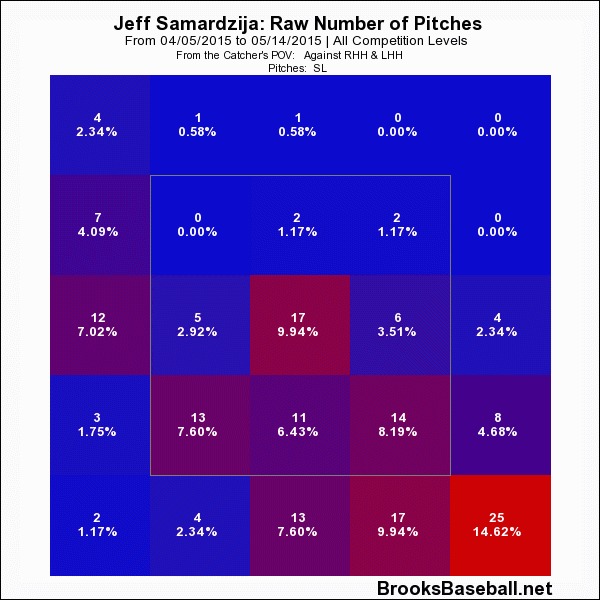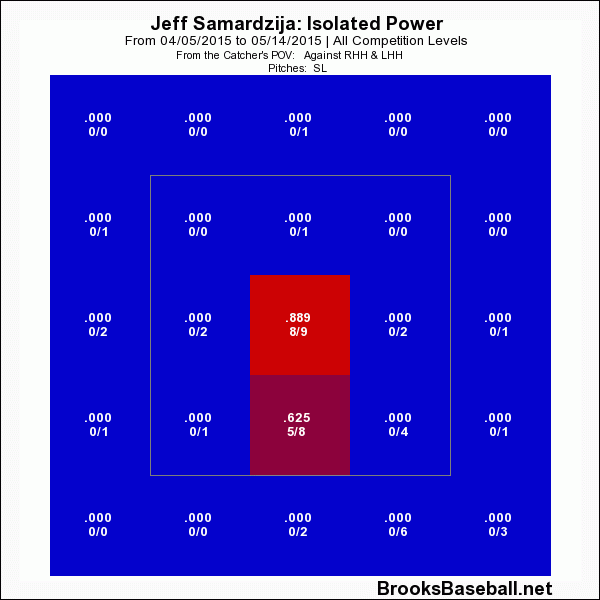Nearly any way you slice it, Jeff Samardzija’s story is one of repeatedly proving the doubters wrong. The right-hander has gone from hyped prospect—more due to name recognition than his performance on the field—to disappointment, to nearly being released, to having a strong season out of the ‘pen, to succeeding and sticking as a starter, to eventually emerging as one of the better ones in the game last summer. Every step of the way, there were few who believed he'd find his footing, and every step of the way, Samardzija added more believers. After spending his entire career with the Chicago Cubs organization, Samardzija found himself traded for the second time in the span of a few months this offseason, returning to Chicago, this time on the South Side.
Acquiring the former Notre Dame football star was supposed to give the White Sox quite the imposing front of the rotation, with Samardzija slotting in nicely between perennial Cy Young candidate Chris Sale, and Jose Quintana, who has his own surprising success story to tell. But seven starts into his Sox career, Samardzija has not been close to what most expected: A 4.80 ERA, 4.27 DRA, 102 cFIP (the latter two indicate he’s not just getting bad lucked), with a couple of career-worsts as a starter: a 17.7 percent strikeout rate and 35.1 percent groundball rate.
It’s those last two numbers that jump out at me and that I’ll dive into shortly. But while Samardzija isn’t locating his fastball as well as he did during his breakout 2014 campaign, it’s not just the heater that he’s failing with.
Here’s Samardzija’s pitch usage since he’s become a full-time starter:
|
Year |
Fourseam |
Sinker |
Cutter |
Curve |
Slider |
Change |
Split |
|---|---|---|---|---|---|---|---|
|
2012 |
32.13 |
22.06 |
9.74 |
1.61 |
15.65 |
0.00 |
18.77 |
|
2013 |
26.05 |
27.67 |
10.40 |
0.00 |
19.83 |
0.00 |
16.02 |
|
2014 |
23.14 |
31.05 |
12.63 |
0.00 |
21.37 |
0.00 |
11.81 |
|
2015 |
20.57 |
22.86 |
23.71 |
0.00 |
24.43 |
0.00 |
8.29 |
There’s a lot going on here, much to digest. As mentioned in the story linked earlier, Samardzija’s four-seamer isn’t being located up and in as often as in the past. It was a plan of attack that’s helped lead to success for Samardzija and it’s unlikely that he’s going away from that game plan. He’s just struggling to command his fastball, and as any pitcher will tell you, it’s nearly impossible to find success on the mound if you can’t locate your fastball. Of course, there are four other pitches currently in Samardzija’s arsenal, and each tells a different tale as to why Samardzija hasn’t carried his 2014 success into the first five weeks of this season.
Early on this year, Samardzija has relied on his cutter more than ever before. Results-wise, it’s been one of his better pitches, as it’s the only offering that opponents don’t have an ISO above .200 against (.063) and it’s his best groundball-inducing pitch at 42.1 percent of balls in play. And while the lack of power against the pitch is nice to see (seriously, when every other pitch is getting slugged above a .200 ISO, Samardzija has to find some comfort in the pitch), the usage appears to be coming at the expense of his sinker and splitter, two pitches that had each garnered high groundball rates over the past three seasons (each above 50 percent) and had been the primary reasons Samardzija notched a career-high 50.2 percent groundball rate last summer.
Part of what contributed to Samardzija’s strong season last year was his ability to induce weak contact early in the game, allowing him to lower his pitch count and go deeper into games. Then, Samardzija would rack up the strikeouts later in the game if and when they were needed—his 37.5 percent strikeout rate in the seventh inning last season was easily his highest by inning. I picked Samardzija’s brain quite a bit during his time on the North Side of Chicago and this was something he and Cubs pitching coach Chris Bosio had been working toward ever since Samardzija made the commitment to being a starter; and the righty seemingly mastered the plan last summer.
This year he’s using both groundball-inducing pitches less, and while his contact rate is at an all-time high as a starter (83.7 percent), it’s obviously not the type of results he’d like to see. And along with the high contact comes the fact that Samardzija just isn’t getting the type of swing-and-miss he’s accustomed to.

When we look at the above chart, we see that the biggest culprit is his splitter, which has taken an eight percentage point hit in whiffs per swing from last year to this. The splitter was a revelation for Samardzija, a pitch that was becoming his go to when in need of the strikeout. For the most part this season, the pitch has been just below the strike zone, exactly where it needs to be, but while opponents are swinging at it as frequently as in the past (the 53.5 percent swing rate is pretty consistent with what we've seen from opponents against Samardzija as a starter), they're not missing at nearly the same rate. Samardzija has admitted that the splitter can be a finicky pitch, one that he often doesn’t know where exactly it may go. He has said that all that matters is that it’s moving and it should be effective. It appears that he’s getting the movement he wants, but batters just don’t appear to be as fooled by the pitch as they had been in the past, at least early on.
But perhaps most interesting of all is what’s happening with Samardzija’s slider. It’s a pitch that has been associated with Samardzija from the very start of his professional career, one that every scout and front office executive felt if he could just harness, he had a chance to be a very good major-league pitcher. It became a recurring theme early in Samardzija's career: Former Cubs general manager Jim Hendry would proclaim the pitch big-league ready, then Samardzija would be called up to the majors and would see the offering get hammered by the opposition.
And as big as the splitter has been for Samardzija, the experts were right: when the slider is working, Samardzija has seen his best results. Last year, Samardzija drew more whiffs on his slider than any other pitch (second most, behind the splitter, percentage-wise) and limited opponents to just a .211 batting average against (and a .122 ISO) on the offering. And, most importantly, he was putting the pitch precisely where he wanted it.

The pitch was generally what would be low and away to a right-handed hitter and the results were what Samardzija was hoping for. This year… not so much.

Samardzija is actually going to the slider more often this season; in fact, he’s using the pitch more often than he ever has a starter, and the results aren’t pretty. As the above chart shows, Samardzija is still getting the pitch in the lower right quadrant of the zone quite frequently. But see that slightly red zone right over the heart of the plate? Simply put, that’s not what he wants to do with the pitch, and the opposition—which, at a 54.4 percent swing rate, is offering at the pitch more often than ever before—is making him pay for his mistakes.

Three of the six homers Samardzija has allowed his season have come on the slider, helping contribute to the .289 ISO he’s allowing on the pitch. And like the splitter, hitters are just whiffing significantly less on his slider.
Samardzija’s struggles can’t be pinpointed to just one pitch that he’s failing to use as much or another that he isn’t locating. There appears to be an issue with every pitch he has to offer. While he’s having some success with the cutter, he’s not generating any more whiffs with it than in the past, and its increased usage is coming at the expense of pitches that induced both more swing-and-miss and groundballs in previous seasons. If not for the 4.5-percentage point jump in whiffs from his four-seamer, Samardzija’s 17.7 percent strikeout rate could look even uglier.
The solution to Samardzija’s problems may not be that simple. It’s easy to say that he should just go to pitches that worked for him in the past more often; but currently, those pitches—the sinker and the split—are getting hit and hit hard. He’s using his slider, but he’s missing with it badly and frequently. Those are pitches that helped lead him to his best season ever, and they don’t appear to be having the same effect as they once did.
There’s no easy fix here. Samardzija has to find his command and get his pitch usage and sequencing right. That’s certainly not out of the question—we already saw Samardzija emerge as a great starter despite every bit of evidence we had suggesting he wouldn't. However, until that happens, the White Sox won’t be able to boast the devastating one-two punch at the top of their rotation that they expected to have when the season began.
Thank you for reading
This is a free article. If you enjoyed it, consider subscribing to Baseball Prospectus. Subscriptions support ongoing public baseball research and analysis in an increasingly proprietary environment.
Subscribe now